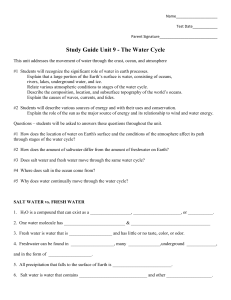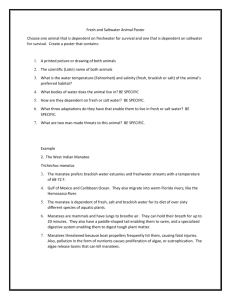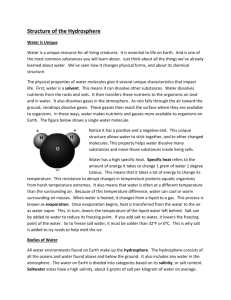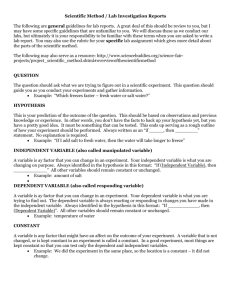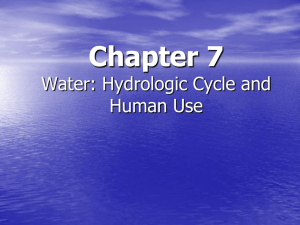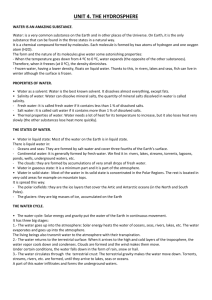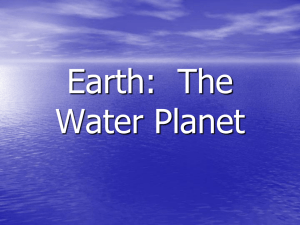Section 2: Water on Earth
advertisement
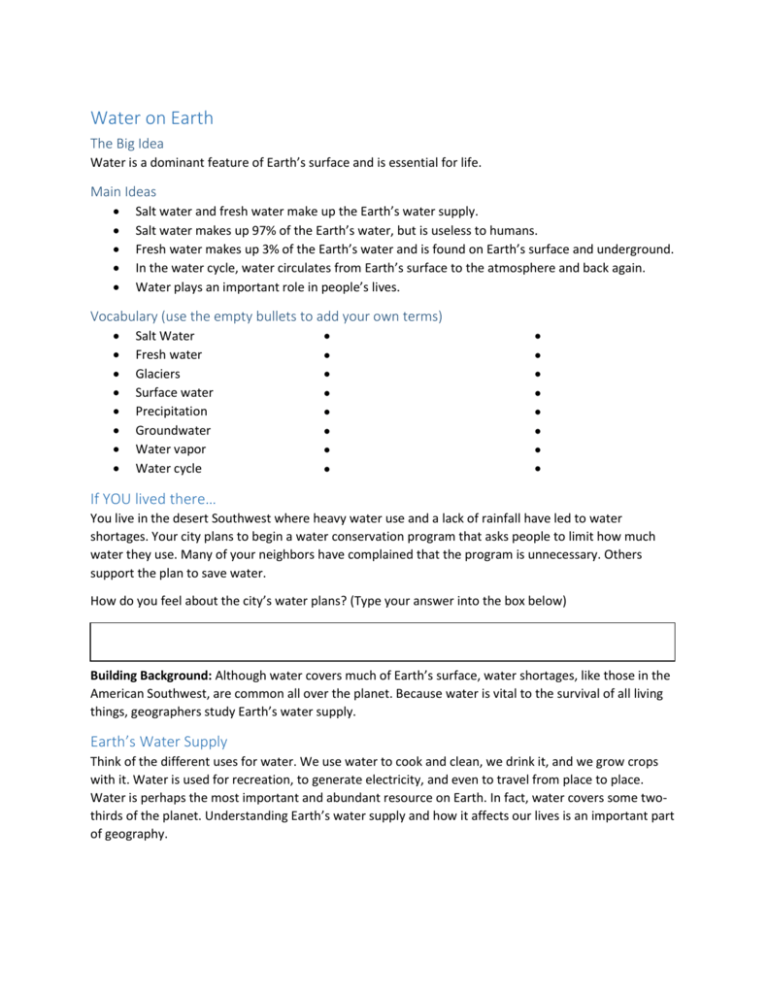
Water on Earth The Big Idea Water is a dominant feature of Earth’s surface and is essential for life. Main Ideas Salt water and fresh water make up the Earth’s water supply. Salt water makes up 97% of the Earth’s water, but is useless to humans. Fresh water makes up 3% of the Earth’s water and is found on Earth’s surface and underground. In the water cycle, water circulates from Earth’s surface to the atmosphere and back again. Water plays an important role in people’s lives. Vocabulary (use the empty bullets to add your own terms) Salt Water Fresh water Glaciers Surface water Precipitation Groundwater Water vapor Water cycle If YOU lived there… You live in the desert Southwest where heavy water use and a lack of rainfall have led to water shortages. Your city plans to begin a water conservation program that asks people to limit how much water they use. Many of your neighbors have complained that the program is unnecessary. Others support the plan to save water. How do you feel about the city’s water plans? (Type your answer into the box below) Building Background: Although water covers much of Earth’s surface, water shortages, like those in the American Southwest, are common all over the planet. Because water is vital to the survival of all living things, geographers study Earth’s water supply. Earth’s Water Supply Think of the different uses for water. We use water to cook and clean, we drink it, and we grow crops with it. Water is used for recreation, to generate electricity, and even to travel from place to place. Water is perhaps the most important and abundant resource on Earth. In fact, water covers some twothirds of the planet. Understanding Earth’s water supply and how it affects our lives is an important part of geography. Salt Water Although water covers much of the planet, we cannot use most of it. About 97 percent of the Earth’s water is salt water. Because salt water contains high levels of salt and other minerals, it is unsafe to drink. In general, salt water is found in Earth’s oceans. Oceans are vast bodies of water covering some 71 percent of the planet’s surface. Earth’s oceans are made up of smaller bodies of water such as seas, gulfs, bays and straits. Altogether, Earth’s oceans cover some 139 million square miles (360 million square kilometers) of the planet’s surface. Some of Earth’s lakes contain salt water. The Great Salt Lake in Utah, for example, is a saltwater lake. As salt and other minerals have collected in the lake, which has no outlet, the water has become salty. Vocabulary Note: “Salt water” is a noun used to talk about water that is salty. “Saltwater” is an adjective used to describe other things, a “saltwater lake”, a “saltwater marsh”, or “saltwater taffy”, for example. Fresh Water Since the water in Earth’s oceans is too salty to use, we must rely on other sources for fresh water. Fresh water, or water without salt, makes up only about 3 percent of our total water supply. Much of that fresh water is locked in Earth’s glaciers, large areas of slow-moving ice, and in the ice of the Antarctic and Arctic regions. Most of the fresh water we use every day is found in lakes, in rivers, and under Earth’s surface. One form of fresh water is surface water. Surface water is water that is found in Earth’s streams, rivers, and lakes. It may seem that there is a great deal of water in our lakes and rivers, but only a tiny amount of Earth’s water supply – less than one percent – comes from surface water. Streams and rivers are a common source of surface water. Streams form when precipitation collects in a narrow channel and flows toward the ocean. Precipitation is water that falls to Earth’s surface as rain, snow, sleet, or hail. In turn, streams join together to form rivers. Any smaller stream or river that flows into a larger stream or river is called a tributary. For example, the Missouri River is the largest tributary of the Mississippi River. Lakes are another important source of surface water. Some lakes were formed as rivers filled low-lying areas with water. Other lakes, like the Great Lakes along the U.S.-Canada border, were formed when glaciers carved deep holes in Earth’s surface and deposited water as they melted. Most of Earth’s available fresh water is stored underground. As precipitation falls to Earth, much of it is absorbed into the ground, filling spaces in the soil and rock. Water found below Earth’s surface is called groundwater. In some places on Earth, groundwater naturally bubbles from the ground as a spring. More often, however, people obtain groundwater by digging wells, or deep holes dug into the ground, to reach the water. Reading Check: Contrasting. How is salt water different from fresh water? (Type your answer in the box below.) The Water Cycle When you think of water, you probably visualize a liquid – a flowing stream, a glass of ice-cold water, or a wave hitting the beach. But did you know that water is the only substance on Earth that occurs naturally as a solid, a liquid, and a gas? We see water as a solid in snow and ice and as a liquid in oceans and rivers. Water also occurs in the air as an invisible gas called water vapor. Water is always moving. As water heats up and cools down, it moves from the planet’s surface to the atmosphere, or the mass of air that surrounds Earth. One of the most important processes in nature is the water cycle. The water cycle is the movement of water from Earth’s surface to the atmosphere and back. The sun’s energy drives the water cycle. As the sun heats water on the Earth’s surface, some of that water evaporates, or turns from liquid to gas, or water vapor. Water vapor then rises into the air. As the vapor rises, it cools. The cooling causes the water vapor to condense, or change from a vapor into tiny liquid droplets. These droplets join together to form clouds. If the droplets become heavy enough, precipitation occurs – that is, the water falls back to Earth as rain, snow, sleet, or hail. When that precipitation falls back to Earth’s surface, some of the water is absorbed into the soil as groundwater. Excess water, called runoff, flows over land and collects in streams, rivers, and oceans. Because the water cycle is constantly repeating, it allows us to maintain a fairly constant supply of water on Earth. Reading Check: Finding Main Ideas. What is the water cycle? (Type your answer in the box below.) Water and People How many times a day do you think about water? Many of us rarely give it a second thought, yet water is crucial for survival. Water problems such as the lack of water, polluted water, and flooding are concerns for people all around the world. Water also provides us with countless benefits, such as energy and recreation. Water Problems One of the greatest water problems people face is a lack of available fresh water. Many places faces water shortages as a result of droughts, or long periods of lower-than-normal precipitation. Another cause of water shortages is overuse. In places like the southwestern United States, where the population has grown rapidly, the heavy demand for water has led to shortages. Even where water is plentiful, it may not be clean enough to use. If chemicals and household wastes make their way into streams and rivers, they can contaminate the water supply. Polluted water can carry diseases. These diseases may harm humans, plants, and animals. Flooding is another water problem that affects people around the world. Heavy rains often lead to flooding, which can damage property and threaten lives. One example of dangerous flooding occurred in Bangladesh in 2004. Severe floods there destroyed roads and schools, affecting about 25 million people. Water’s Benefits Water does more than just quench our thirst. It provides us with many benefits, such as food, power, and even recreation. Water’s most important benefit is that it provides us with food to eat. Everything we eat depends on water. For example, fruits and vegetables need water to grow. Animals also need water to live and grow. As a result, we use water to farm and raise animals so that we will have food to eat. Water is also an important source of energy. Using dams, we harness the power of moving water to produce electricity. Electricity provides power to air-condition or heat our homes, to run our washers and dryers, and to keep our food cold. Water also provides us with recreation. Rivers, lakes, and oceans make it possible for us to swim, to fish, or to sail a boat. Although recreation is not critical for our survival, it does make our lives richer and more enjoyable. Reading Check: Summarizing. How does water affect people’s lives? (Type your answer in the box below.) Summary and Review: In this section you learned that water is essential for live on Earth. Next, you will learn about the shapes on Earth’s surface. Section 2 Assessment Reviewing Ideas, Terms, and Places 1. Vocabulary a. Describe: Name and describe the different types of water that make up Earth’s water supply. b. Analyze: Why is only a small percentage of Earth’s fresh water available to us? c. Elaborate: In your opinion, which is more important – surface water or ground water? Why? 2. Vocabulary a. Recall: What drives the water cycle? b. Make Inferences: From wat bodies of water do you think most evaporation occurs? Why? 3. Vocabulary a. Define: What is a drought? b. Analyze: How does water support life on Earth? c. Evaluate: What water problem do you think is most critical in your community? Why? Critical Thinking 4. Sequencing: Make a graphic organizer identifying the states in Earth’s water cycle. Writing 5. Learning about Water: A haiku is a traditional form of Japanese poetry that contains seventeen syllables and is usually three lines long. The first line contains five syllables, the second contains seven, and the third contains five. Make a list of ten words that describe water and the Earth’s water supply and put them into a haiku about water.
